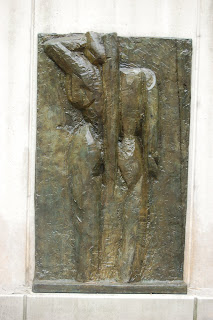We like to put labels on things: this is my handle, this is my spout. When get tired of directly labeling, we use comparisons. When we feel the need to go beyond the explicit and implicit comparisons into the poetic, we enter the subjective realm of metaphors. Art exists somewhere in between this continuum. In between the extreme and narrow direct representation labeling, to the highly abstract, non-figurative and symbolic, we have the ability to find an access point into the work. Some works cover more of the continuum which allows for diverse entry points and open different interpretation tangents, where others are much more narrow, offering limited paths of discourse. More so, I find the extremes of this continuum are much more difficult to access aesthetically, and our response becomes more logical, directed, and intellectual.
Defining art is nearly impossible. The artistic fields are no longer clearly defined. The classical arts made it easier for us to distinguish theater, music, visual, and dance. Things that have artistic merit but did not fall into these categorizes are a kind of art: cultural artifacts. Cross-discipline artists, technology, globalization and exponential communication mediums have expanded the realm and continue to challenge the art compass. At the same time, the labels continue to be created as our drive to classify and arrange our world into neat compartments remains a part of our anthropological make-up.

So unless these works are shown to us in context which can easily be recognized as artistic works (i.e. a gallery, museum, performance, etc.), sometimes it can really be difficult to recognize art. The last art essay discussion group at the Contemporary Arts Museum Houston, we dove right into the intersection of science in, about and through art. This is not a new concept. I am a believer that cultural contexts always show up in artists genres, so whatever happens to be in the forefront of anthropological development will make an appearance.
We can use science as a tool (as in computer music), as a vehicle (as in photography or film) or as a topic. One could argue that science has always been used as a tool in the creation of instruments (in seeking the most resonant sound and stable scales) and paint (creating colors hues, and textures). Da Vinci's Vitruvian man attempts to explain classical architectural proportions through the canon of proportions. Although some may argue that this is an example of blend between art and science, one could question where this is an illustration for explanation purposes. Artistic merit, or artistic components does not equate to a work of art. For example, I think we could all agree that a toilet bowl cleaner designed by Michael Graves, as pretty as it can be, would not enter the realm of art, unless it was displayed in a box in a museum somewhere.

A retinal exam can produce such gorgeous images that could be confused for art without any further need for manipulation.

Images of the Hubble telescope are fantastic and appear to be beyond the realm of most people's realities, that can explicitly provoke an aesthetic response beyond its documentary and illustrative purposes.
In the discussion group, a participant explained: "if you do something so well that it pushes the envelop of that field, it becomes artistic and can be considered art." I think this measure can be applied sometimes. I recall a discussion on the topic of culinary arts. Some chefs employ such virtuosic techniques in their craft, that combining the presentation with preparation techniques can present something so spectacular and unexpected that it transcends craft. Can cooking then become a performing art of some sort? An interaction between artist and audience where the consumer becomes a performer?

So, does art then become about the original intent of the work? Seems like this would be a natural place to start: the origins. After all, since we always seem to be fascinated with stories, histories and where things came from, it would be logical to conclude that to recognize art you have to look at the intent at the starting point. But that is not always accessible, existent, and practical.
Perhaps that is a reason why there is such diverse art discourse.






 Jo Zider's Too Many Lies; So Little Taste brings together religious connotations, humor, and perhaps a touch of sexuality. Often people consider the tongue as the "strongest' muscle in the human body due to speech. It is used to communicate, nourishment and physical pleasure. Personally, I recalled horrific images of my grandmother's favorite dish at Friday night dinner's: Beef tongue. Zider's arrangement of an overcrowding number of tongues would suggest a commentary on the prevalence of dishonesty while dismissing the psychological and nutritional nourishment that properly used tongues can accomplish. Makes one think of white lies that often are told to escape awkwardness, often to complicate situations to an exponential degree. The composition is highly unique, although it did make me think about the Rolling Stones iconic tongue as well.
Jo Zider's Too Many Lies; So Little Taste brings together religious connotations, humor, and perhaps a touch of sexuality. Often people consider the tongue as the "strongest' muscle in the human body due to speech. It is used to communicate, nourishment and physical pleasure. Personally, I recalled horrific images of my grandmother's favorite dish at Friday night dinner's: Beef tongue. Zider's arrangement of an overcrowding number of tongues would suggest a commentary on the prevalence of dishonesty while dismissing the psychological and nutritional nourishment that properly used tongues can accomplish. Makes one think of white lies that often are told to escape awkwardness, often to complicate situations to an exponential degree. The composition is highly unique, although it did make me think about the Rolling Stones iconic tongue as well.

 I had the opportunity to hear artist Karyn Olivier at
I had the opportunity to hear artist Karyn Olivier at 










